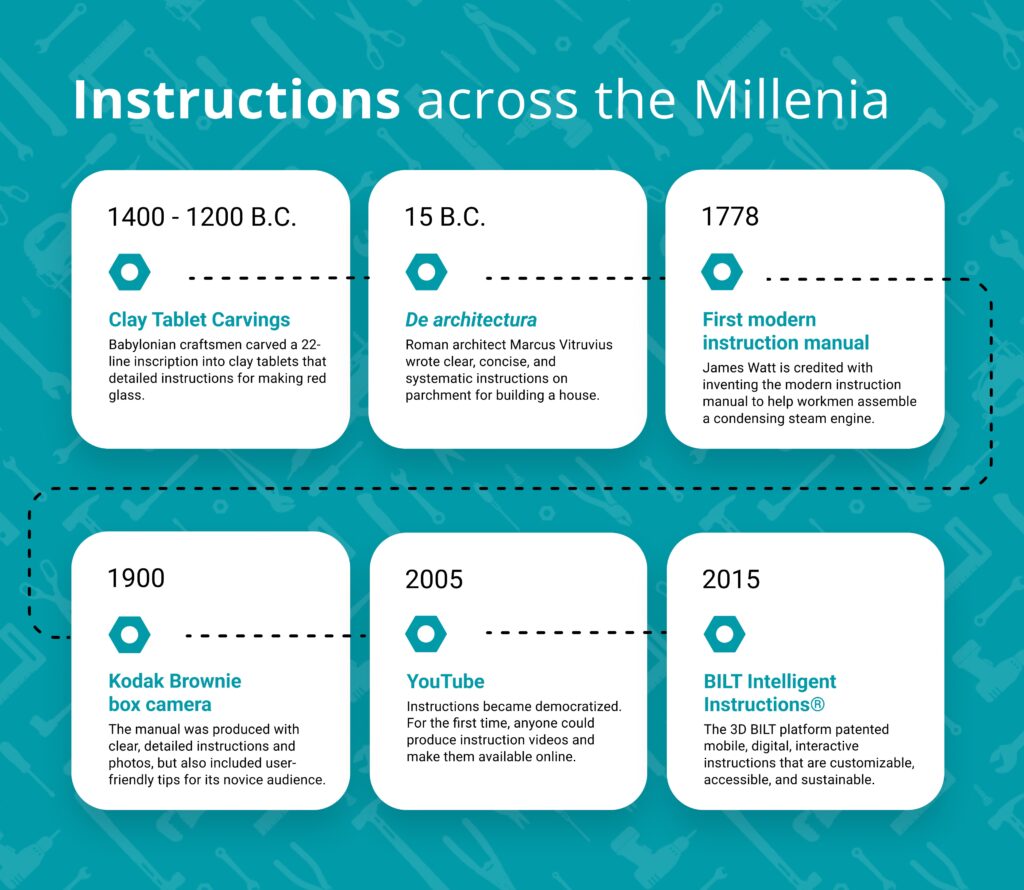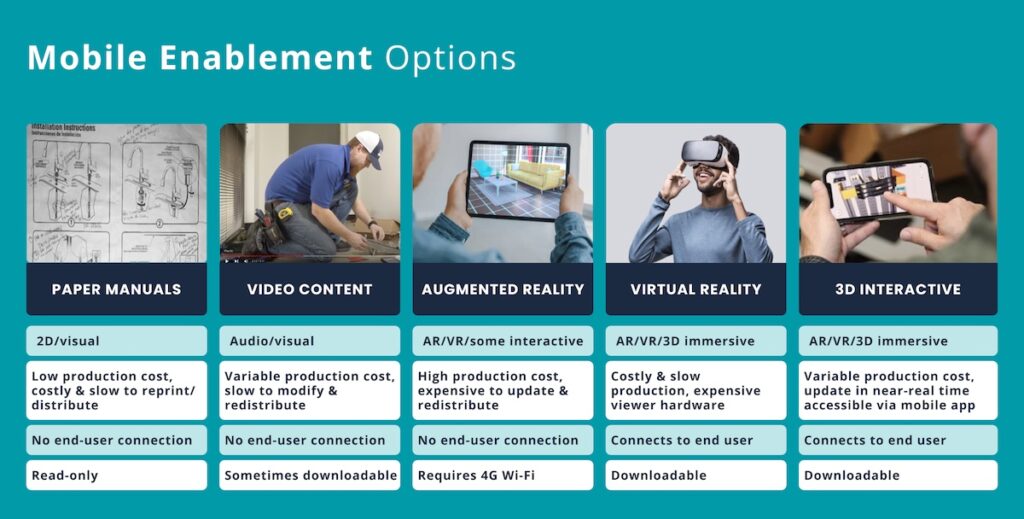Overview
This white paper will evaluate the return on investment of prioritizing instruction quality. It explores how poor instructions negatively impact a business from many perspectives. It examines the long-term effects of improving instructions for consumers and professional training, including increasing customer and employee satisfaction.
Although there have been innovations in technology and the marketplace, instructions haven’t kept pace with modernization. We will share four common instructional mistakes and provide insight into learning styles, including demographical data about how users react to instructions.
We hope you’ll find the information enlightening and helpful in your quest to give customers and employees the best instruction experience possible.
This article is also available as a PDF download to share with stakeholders.
A Brief History of Instructions
Archaeologists date the earliest instructions to between 1400 and 1200 B.C. when ancient Babylonian craftsmen carved instructions into clay tablets. The 22-line inscription detailed a recipe for making red glass.
Roman architect Marcus Vitruvius wrote De architecturaon parchment before 15 B.C. Mark Svenvold classifies it as “one of the only true manuals to survive from antiquity.” It provided clear, concise, systematic instructions on building a house.
Scottish engineer James Watt is credited with inventing the modern instruction manual. Watt’s 1778 Instruction Book included design drawings and ordered steps to help workmen assemble a condensing steam engine. Watt’s first instruction sheet was a step-by-step usage guide for a copying machine, a forerunner of today’s photocopiers. Watt had the foresight to glue the single sheet to the machine for convenience.
Another landmark manual was developed in 1900 for the release of the iconic Kodak Box Brownie camera, which made photography accessible and affordable for the masses. The manual was noteworthy not only because it was beautifully produced with clear, detailed instructions and photos, but also included user-friendly tips for its novice audience on how to take a picture.
During the 20th century, instructions advanced with radio, film, video tape, the internet, digital media, smartphones, and mobile apps, but it wasn’t until the introduction of YouTube in 2005 that instructions became democratized. Anyone could make product instruction videos universally available online. With 35 billion users, YouTube is the second largest website on the internet. Google owns YouTube and preferentially directs its 93 billion users to YouTube for video content. In 2023, the four of the most popular categories on YouTube include:
- Product review videos
- How-to videos
- Testimonials
- Unboxing videos

Today, we rely on instructions for a range of activities from assembling furniture, to jump-starting a car, to learning install, maintain and repair complex equipment. Instructionsaren’t just a practical way to convey information; they also reveal how technology has changed behavior.
How the Marketplace Evolved
Seven developments in the past two decades impact companies providing instructions for products.
- A decline in manual labor-related proficiency: Knowledge about how to use hand tools and perform specific tasks—such as building a fire—is often passed down from generation to generation. However, there’s a growing deficit in mechanical proficiency in the modern population. Younger generations report a lack of ability when it comes to labor-related tasks such as assembly and installation projects. Generation Z, those born after 1997, are the least “handy” and the least likely to own tools.
- Technological innovation: Every year, new technology is introduced into the marketplace. As products become increasingly high tech, their set up and maintenance become more complex. The global pervasiveness of ecommerce and global shipping has resulted in flat-packed products arriving in smaller, more easily delivered boxes. This increases consumers’ responsibility for at-home setup from smaller components.
- Reliance on mobile phones: Smartphones provide a powerful global information system at our fingertips. In 2023, there are more than 5.2 billion smartphone users, at least 66% of the global population, providing the primary platform for news, learning, and research, including how to assemble and install products.
- Globalized distribution: More companies distribute their products internationally than ever before. This means instructions must be developed for dozens of languages, which often increases the pervasiveness of mistakes. Poor translation results in a confusing or frustrating experience for users.
- Proliferation of consumer reviews: Research indicates at least 93% of consumers read online reviews prior to purchase. As consumers take an increasingly research-driven approach to buying, they make purchase decisions based on what reviewers say about product assembly, usage, and/or maintenance. In short, instructions build trust and credibility with potential buyers.
- Pandemic fallout: The COVID-19 pandemic resulted in a higher demand for products consumers could set up on their own. This increased need for ready-to-assemble (RTA) and direct-to-consumer (DTC) products. The shift placed a greater emphasis on instructions to guide do-it-yourself (DIY) projects and help consumers assemble and install products without the aid of a professional or white glove delivery team.
- Advancement in learning pedagogy: Researchers developed a deeper understanding of how humans process information and manage cognitive load. Scientists advanced new strategies for training, methods to overcome deficiencies, and tools to deliver information.
How Instructions Failed to Adapt: Four Key Mistakes
Although the marketplace has evolved, many companies have not modernized their approach to instructions. Let’s explore four critical errors manufacturers make with instructions.
1. Failure to account for differences in learning style
Because everyone learns differently, a one-size-fits-all approach to instructions is ineffective. Researchers have identified three primary learning styles. While humans have the capacity to learn through any of these methods, most people favor a dominant style.
- Visual learners favor learning by sight. In a classroom setting, they notice the instructor’s facial expressions and body language to understand the content of a lesson. Visual learners are attentive; they tend to sit at the front of the classroom to avoid visual distractions and typically take notes. Visual learners think in pictures and are adept at absorbing written information in books and from graphs, colors, maps, and displays.
- Auditory learners absorb information by listening, hearing, and speaking. They prefer lectures, discussions, and brainstorming. They interpret the underlying meaning of speech by listening to voice tone, pitch, and speed, as well as other verbal nuances. Written information has less meaning to auditory learners until they “hear” it by reading text aloud, even silently in their own head.
- Kinesthetic learners learn by experiencing, moving, touching, and doing. They take a hands-on approach and actively explore the physical world around them. They dislike sitting still for long periods of time, and can become distracted by their need for activity, physical manipulation, and exploration. An example of kinesthetic learning is when a child figures out how to ride a bike.
Keep the following in mind when considering how consumers absorb information. Humans retain about:
- 10% of what we see
- 30-40% of what we see and hear
- 90% of what we see, hear and do

Companies should strive to use visual and audio technologies to integrate all three elements in their instructions for optimum learning performance. It also helps users better connect with instructions. Research shows adding relevant visuals to words results in a nearly 90% improvement in learning outcomes. Including audio makes it easier to understand complex visuals.
Cadence and tone are important in instruction narration because assembly, installation, setup, maintenance, and repair can be mentally strenuous and stressful. The ideal instructor persona is helpful, friendly, concise, clear, and reassuring.
2. Neglecting instructions as an integral part of the customer journey
Brands should maintain a consistent communication style at every touchpoint, including instructions—the critical last touchpoint of the customer journey. If the brand voice is friendly and engaging, instructions should not be dry and detached.
A frustrating experience with instructions leaves a lingering negative impression of the brand; research indicates 77% of consumers who had a bad experience with a product’s instructions would not buy the product again and 81% would not buy another product from the same manufacturer.
In the trades, installers and professional technicians are influential in making product recommendations to customers. If certain products are easier to set up or come with better instructions, contractors are more likely to recommend them to consumers. Professionals understand the better the instructions, the easier it is to train new workers. Less instruction confusion leads to fewer errors, calls to technical support, and callbacks. Increased worker satisfaction reduces turnover and empowers employees. The more efficient the projects, the more profitable the company will be overall.
Manufacturers that dismiss the importance of instructions miss the opportunity to capitalize on a critical moment in the customer journey. A consumer’s emotions about a purchase are strongest or most raw within an 8- to 12-hour window of opening the box, the period that includes assembly or installation. Research indicates during this time, consumers are most likely to talk about a brand by name, whether in person or online in a rating or review.
It’s a dicey moment for a brand. Reviews can be superlative with the elation of a smooth setup or filled with rage after a disastrous one.
Another reason to improve instructions? Customer experience author Jon Picoult says because there are peaks and valleys of satisfaction along the customer journey, brands should strive to end on a peak. A strong final summit has a “halo effect” that minimizes the negative emotions experienced in the valleys.
If brands rely heavily on user-generated content (such as reviews or star ratings) to assess customer feedback and take action, the damage may already be done. Prospective customers may read those reviews, too, and avoid your brand or product before you’ve had the chance to correct your mistakes. Retailers also track these results, and decide not to carry a product line because of too many negative reviews or returns back to their store.
Companies should focus on intercepting customer feedback and responding to negative reviews as quickly as possible. Finishing the customer journey on a peak during the assembly or installation stage is one way to accomplish that.
3. Failure to realize how quickly brand reputation can be injured
A recent study by the Brigham Young University (BYU) Marketing Lab explored the impact of product instructions on brand perception and buyers’ willingness to pay for a product. Researchers interviewed 797 respondents of different ages, genders, and income levels.
According to the study, 85% of respondents categorize having access to clear product instructions as “very important.” Despite that majority sentiment, 46% of those surveyed said in general, paper instructions didn’t make it easier for them to successfully accomplish most tasks. Almost half of respondents reported that instructions failed them as consumers. Research indicates 80% of traditional user manuals and instructions are ineffective.
The White House Office of Consumer Affairs estimates dissatisfied customers typically tell 9 to 15 others about their experience; some tell more than 20. The Customer Experience Impact Report reports 86% of consumers quit doing business with a brand after a negative experience.
Research by Andrew Thomas shows it takes roughly 40 positive customer interactions to overcome the damage of a single negative review. That’s because consumers who have a negative experience are much more likely to leave a review than the (roughly one in ten) satisfied customers who weigh in. Thomas says in order to maintain a 4-star average, brands need at least four 5-star reviews to counterbalance a single 1-star review.
Poor instructions open the door to customer frustration. Social media platforms, online review sites, and other forums provide easy access to large audiences. In short, it’s never been easier for customers to kick that door wide open. Word of mouth used to take months or years to incrementally affect brand perception. Now, consumer viewpoints can be broadcast worldwide within seconds, resulting in lasting damage before brands even have time to react.

4. Misunderstanding the damage caused by poor instructions
The ripple effect of a negative instruction experience spreads much farther than most companies realize. Poor instructions can lead to higher operating costs; for products that require assembly, an estimated 40% of all support contact and returns are the result of bad instructions.
Research indicates manufacturers ranked “best in class” for high-quality, useable instructions saw a 23% increase in consumer satisfaction and an 18% increase in revenue as compared to those ranked lowest. Those numbers are consistent with Picoult’s findings over more than a decade, that companies in the top-tier, the customer experience “leaders,” significantly outperform the broader market (the S&P 500 index) and generate a cumulative total return 3.4 times greater than the bottom-tier customer experience “laggards.”
The Impact of Instructions: A Data-Driven Perspective
Here are five reasons to improve instructions:
1. Instructions affect reviews and sales.
The BYU study indicates effective product instructions are crucial for a positive customer experience and increase the likelihood of customer recommendations.
User-generated content (UGC) impacts sales. Research shows when shoppers engage with UGC prior to a purchase it results in a 144% boost in conversion rates, and a 162% lift in revenue-per-shopper.[1] Additionally, 85% of consumers consider user-generated videos or photos to be more authentic and influential than advertising and marketing content created by brands.[2]
Another study suggests even small improvements in star ratings—such as an increase from 4.2 to 4.45 stars—can generate up to an additional 25% in top-line sales.[3] Companies that improve their product instructions can expect an increase in revenue.
2. Customers will pay for a better experience.
Today, customers want more than a product; they expect an experience and they’re willing to pay for it.
According to the BYU study, almost 70% of those surveyed would pay more for a product that provides a superior setup. The average price respondents said they are willing to pay for an easy assembly or installation was an average 34% over the cost of the product.
3. A successful setup increases customer confidence.
Two-thirds of those surveyed said they decided against buying a product because of apprehension about assembling it. Top reasons behind their concerns included:
- Complexity of assembly
- Difficulty understanding the instructions
- Lack of knowledge or experience in the assembly process
- Fear of wasting time and money
Supporting the setup process with clear, accessible, easy-to-follow instructions generates consumer confidence.
4. Instructions strengthen brand loyalty.
The shelf-life of a customer’s experience in the assembly or installation stage can be long-lasting. Nearly 60% of BYU study participants said their overall product satisfaction was impacted by the instructions. Research shows loyal customers are less price sensitive than other shoppers that jump from brand to brand.
5. A successful setup creates a sense of accomplishment.
Manufacturers with complex products face a more difficult instructional challenge. Because setup reveals all, brands can optimize a lengthy or intricate setup to showcase the quality of materials, thoughtful design, or clever engineering.
A Harvard study suggests consumers place greater value on products they assemble or install themselves.[4] Participants assessed their amateur efforts akin to expert work. The “IKEA Effect” explains the perceived increase in value of self-assembled products. People derive satisfaction from successfully tackling a tough project like assembling a trampoline, installing a faucet, or putting together a dollhouse.
So, there are intangible rewards for brands that skillfully guide customers through the assembly or installation process. Loyalty increases when consumers and professionals associate a sense of accomplishment with your brand.
The Cost of Bad Instructions
Manufacturers rarely understand the financial impact of poor instructions. A frustrating setup experience affects brand perception and bottom-line performance. Infuriating instructions are linked to 12 negative outcomes including:
- A higher rate of product returns
- A heavier burden on customer support staff (potentially leading to frustrated employees and decreased morale)
- A growing distrust of a product or product line
- A reduced likelihood of repeat purchases
- An overall decrease in sales
- A spike in the volume and intensity of negative customer reviews
- Lower star ratings
- Less favorable product line reviews from retailers
- A potential increase in safety hazards (and greater risk of liability for companies)
- Pervasive paper waste and negative impact on environmental, social, and governance (ESG) initiatives
- Tarnished brand reputation
- An overall decrease in customer loyalty
Consumer dissatisfaction with instruction manuals is widespread. According to the BYU study:
- 62% of respondents had a negative experience with a brand based on poor instructions
- 32% of respondents have either returned or stopped using a product because of poor instructions
- 30% of those disappointed with a product’s instructions felt the product was overpriced
Consequently, if a customer feels a product’s instructions don’t measure up to expectations, they may not give the brand another chance.
Which Consumers are Most Impacted by Instructions?
Just as humans don’t all learn the same way, people value instructions differently.
Younger consumers have higher expectations than their elders. For example, members of Generation Z and millennials are willing to pay the most for a product with the best instructional experience—more than double the amount the average baby boomer would pay. A contributing factor may be that younger individuals consider themselves to be less handy than those over 40 when it comes to assembling or installing products.
Gen Zs and millennials are less loyal to specific labels than older generations; they’re open to exploring other options, even if they have a favorite brand. (In another study, more than half of Gen Zs interviewed say they have no problem switching things up and trying new brands.[5]) They’re more loyal to causes—such as equal access and sustainability—than companies. Younger consumers are also accustomed to information at their fingertips, and they embrace digital solutions.
When creating instructions, brands should consider the age and priorities of the target consumer.
Related: The Dyslexia Dilemma: Why Written Instruction Manuals Fall Short in Employee and Customer Experience
Instruction Platform Options
There are several instruction platforms available, each with strengths and weaknesses. An excellent instructional choice for one manufacturer may not be ideal for another. Here are five options for instruction delivery.
- Paper: Paper instruction manuals are a viable option for many product companies. These instructions are low-tech and inexpensive to create. Paper manuals are ideal for companies with basic instructional needs or compliance-related mandates. It is expensive and time-consuming to reprint and redistribute paper instructions when product updates or instruction changes necessitate edits. Paper instructions are easily lost or discarded, and only offer a limited view of the assembly or installation processes.
Paper manuals undermine ESG efforts. Almost 80% of consumers surveyed prioritize sustainability, and more than 70% are willing to pay a premium for environmentally responsible brands.[6] - Digital: Digital instructions can be updated quickly, distributed affordably, and support sustainability initiatives. But if digital instructions are merely PDF versions of paper manuals, they have similar limitations in addressing users’ learning styles.
- Videos: Video instructions are a popular way to crowdsource information; any consumer can produce their own video tutorial regardless of their level of expertise.
Professional instructional videos (sometimes called explainer videos or industrials) are more expensive and must be re-shot, edited, and redistributed when updates are required. Most videos require internet access in order for viewers to follow along. - Virtual Reality (VR) and Augmented Reality (AR): VR/AR technology has been in development since the early 1990s. The difference between VR and AR instructions is that VR is a set of computer-generated images and sounds where users are fully immersed in a fictional environment. Traditional VR requires glasses or goggles, though some simulations can be accessed on a computer or headset. Most manufacturers recommend VR should not be used more than 30 minutes at a time; users report side effects including dizziness, headaches, nausea, and eye strain. The average cost per VR headset in the United States is $430.
Augmented reality overlays the real world with digital content, so users can still see their environment. Most AR training is accessed via smartphone application and camera, but the market for AR glasses or goggles is growing. Most wearable AR includes both front and back cameras and sensors. The cost per headset ranges from $100 to $6,000 depending on functionality.
AR and VR are expensive to produce. Digital environments are typically custom-built and may require a long production time. - 3D interactive: 3D interactive instructions are accessible on a touchscreen device and delivered via mobile application. Once instructions are downloaded, they can be accessed without wifi. Manufacturers retain control of their content and can modify instructions in near-real time. Interactivity permits the user to customize their experience. Users can view CAD animated instructions from any angle by rotating images and zooming in. Manufacturers can track aggregated time-in-step data to analyze complex steps and simplify instructions or improve product engineering.
Some 3D instructions platforms allow customers to leave a product rating and review, which increases the likelihood of more direct, immediate feedback.
Mobile Training & Enablement Options

Summary
Instructions are no longer carved into clay tablets, but can delivered digitally to a smartphone or mobile tablet. Technology has evolved faster than instruction design.
Manufacturers have often neglected the setup experience as a key episode in the customer journey. But brands are beginning to recognize the negative downstream impact poor instructions have on their bottom line. Today, consumers are more sophisticated and demanding about their overall interactions with a new product. Customers are less loyal, too, with many options available.
To provide a superior instruction experience, manufacturers should convey information in a detailed, accurate, easy-to-comprehend manner, taking into consideration the differences in customer learning styles, demographic-driven preferences, and available platforms.
Brands that provide premium instructions will increase star ratings and improve reviews, boost sales, differentiate from the competition, and reduce returns and customer support costs.
This article is also available as a PDF download to share with stakeholders.
[1] https://www.bazaarvoice.com/blog/the-complete-guide-to-ugc/
[2] https://www.adweek.com/performance-marketing/why-consumers-share-user-generated-content-infographic/
[3] https://www.mckinsey.com/industries/consumer-packaged-goods/our-insights/five-star-growth-using-online-ratings-to-design-better-products
[4] https://www.hbs.edu/ris/Publication%20Files/11-091.pdf
[5] https://www.oliverwymanforum.com/global-consumer-sentiment/a-gen-z.html?cid=other-eml-mtg-mip-mck&hlkid=0094d63a56364c959afa015e4602da26&hctky=13091879&hdpid=a1e08c0f-a682-4635-a8e1-e23f6e12035a
[6] https://www.ibm.com/downloads/cas/EXK4XKX8
With our fully 3D interactive platform, BILT offers both the technology and the time-tested insights to deliver a winning experience for your customers—and your business. We’re here to help whenever you decide to reach out.




